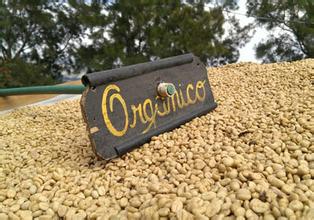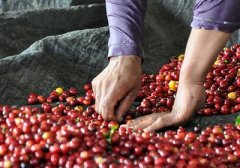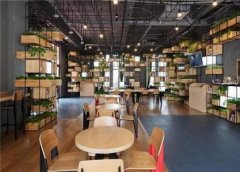A brief introduction to the cultivation of glossy Kenyan boutique coffee beans, geographical location, climate and altitude

Kenyan coffee
Some buyers, especially Japanese businessmen, have expressed dissatisfaction with the Kenyan coffee industry system. Some businessmen say that the quality of coffee in the country has declined, and point out that buying directly from farmers may be a way to improve the quality. But in any case, Kenya's detailed rules and regulations and sound procedures are a model for all coffee-producing countries.
Kenyan Coffee became more famous with the sensation of the Hollywood movie OutofAfrica.
Karen, the heroine played by Meryl Streep (MarylStreep), is a writer and coffee plantation owner. Many people may still remember the beautiful scenery and the magnificent sunset in the film, but what is even more unforgettable is Karen's dream of having a coffee plantation in Africa.
Most Arabica coffee beans mature from June to August and Robasta coffee beans from September to October. Therefore, although in some countries where the dry and wet seasons are not obvious, such as Colombia and Kenya, there are two flowering periods a year, that is, two harvests, but strictly speaking, there is only one harvest a year.
The harvest time of coffee varies from region to region. Regions north of the equator (such as Ethiopia and Central America) are generally harvested from September to November. South of the equator, such as Brazil and Zimbabwe, although the harvest can last until August, the main one is in April or May. Countries in the equatorial region, such as Uganda and Colombia, can harvest all year round, especially those plantations that can make good use of different elevations. As a result, there may be new coffee beans for most of the year.
Coffee fruits should be harvested immediately, and it is not easy to harvest coffee fruits at different ripening stages on the same tree. Generally speaking, it takes as long as 4-5 months to receive a full harvest from the initial harvest. If ripe and immature fruits are harvested at the same time, the quality of coffee will be reduced. Therefore, good quality coffee is picked one by one by hand, in order to maintain the perfect taste of coffee.
The Kenyan government takes the coffee industry very seriously, where it is illegal to cut down or destroy coffee trees. Kenyan coffee buyers are world-class high-quality coffee buyers, and no other country can grow, produce and sell coffee on a continuous basis like Kenya. All coffee beans are first acquired by the Kenya Coffee Commission (CoffeeBoardofKenya, CBK), where they are identified, graded, and then sold at weekly auctions, where they are no longer graded. The Kenya Coffee Commission only acts as an agent to collect coffee samples and distribute them to buyers so that they can determine the price and quality. The auction in Nairobi is for private exporters, and the Kenya Coffee Commission pays growers a price below the market price. The best coffee grade is bean berry coffee (PB), followed by AA++, AA+, AA, AB and so on. The fine coffee is shiny, delicious and slightly alcoholic. Auctions are also organized to meet the needs of dispatchers. This kind of auction usually has a small auction volume (3-6 tons each), with samples with the grower's logo for buyers to enjoy. After the auction, the exporters pack according to different flavors, different qualities and the quantity required by the blenders. This provides a great deal of flexibility for the dispatcher. Quality-conscious Germans and Scandinavians are long-term buyers of Kenyan coffee.
A total of six concentric circles are needed at this stage. After the smallest flow of water is injected into the center point by hand for 2 seconds, the concentric circle is around the first circle, and then each concentric circle is enlarged 1 turn accordingly. To the fifth concentric circle, about 12.5px away from the wall of the filter cup, all powder layers will be wet to water and washed away. Then, go back to the fourth concentric circle. The third stage will explain in detail how to circle the third lap.
After circling 6 concentric circles, the electronic claim will show that the amount of water is about 70-80 grams (including 31.8 grams of water used for steaming). If it exceeds 80 grams, the flow is too large, and you must practice the smallest flow and circle it. Use this thin water to slowly circle and disperse the powder layer formed by steaming, and all the powder is wet to the water, determining the direction of the taste. The first feeling of drinking coffee is that the taste is distributed to the whole mouth, and every taste bud can feel the coffee, which can improve the cleanliness and sweetness.) This stage of the flow requirements is the lowest, even if you break the flow does not affect the taste, as long as it can be wet to all the powder. If the filter paper is washed on the filter paper during the circle at this stage, the water on the filter paper will be absorbed by the powder layer, because when the fine water flows around, the water absorption rate of the powder layer is slow and the water in the powder layer is not saturated.
On the contrary, hand flushing is popular in China. The water is also injected at the central point, but the flood flows around 2-3 times, and the water in the powder layer is saturated. The large current has a great impact on the powder layer, and many people do not dare to go to the extreme edge, so they can only circle around the center point and the middle part of the filter cup wall. the large water flow will quickly push up the powder layer, and some of the steaming powder layer on the far side will be relatively dry relative to the central point, resulting in insufficient extraction. (taste trend: the first taste of drinking coffee is included in, and the coffee liquid flows directly down to the throat, resulting in a strong taste and easy to have raw and mixed smell.)
Important Notice :
前街咖啡 FrontStreet Coffee has moved to new addredd:
FrontStreet Coffee Address: 315,Donghua East Road,GuangZhou
Tel:020 38364473
- Prev

A brief introduction to the market price of Kenyan boutique coffee beans with rich taste
In addition to having obvious and charming fruit acidity, because most Kenyan coffee comes from small coffee farmers who know how to brew coffee and do not know how to taste coffee, then the original delicacy may also become tasteless. Some people taste coffee with the taste of the tongue, while others enjoy the aromatic mellow in the mouth. in addition, it depends on the body when drinking coffee.
- Next

A brief introduction to the treatment method of grinding degree and baking degree of delicious Kenyan boutique coffee beans
Kenya coffee harvest season there are two harvest seasons in Kenya, the main harvest season is from October to December and the secondary harvest season is from May to July. Large coffee processing farms in Kenya usually have independent processing facilities. A large number of small farmers usually pick ripe coffee fruits by hand. Coffee picking is a labor-intensive job, which requires the whole family to go out or even return during the harvest season.
Related
- Detailed explanation of Jadeite planting Land in Panamanian Jadeite Manor introduction to the grading system of Jadeite competitive bidding, Red bid, Green bid and Rose Summer
- Story of Coffee planting in Brenka region of Costa Rica Stonehenge Manor anaerobic heavy honey treatment of flavor mouth
- What's on the barrel of Blue Mountain Coffee beans?
- Can American coffee also pull flowers? How to use hot American style to pull out a good-looking pattern?
- Can you make a cold extract with coffee beans? What is the right proportion for cold-extracted coffee formula?
- Indonesian PWN Gold Mandrine Coffee Origin Features Flavor How to Chong? Mandolin coffee is American.
- A brief introduction to the flavor characteristics of Brazilian yellow bourbon coffee beans
- What is the effect of different water quality on the flavor of cold-extracted coffee? What kind of water is best for brewing coffee?
- Why do you think of Rose Summer whenever you mention Panamanian coffee?
- Introduction to the characteristics of authentic blue mountain coffee bean producing areas? What is the CIB Coffee Authority in Jamaica?

